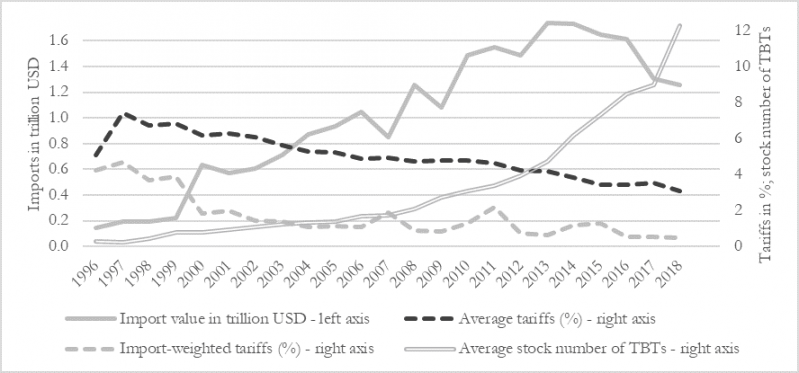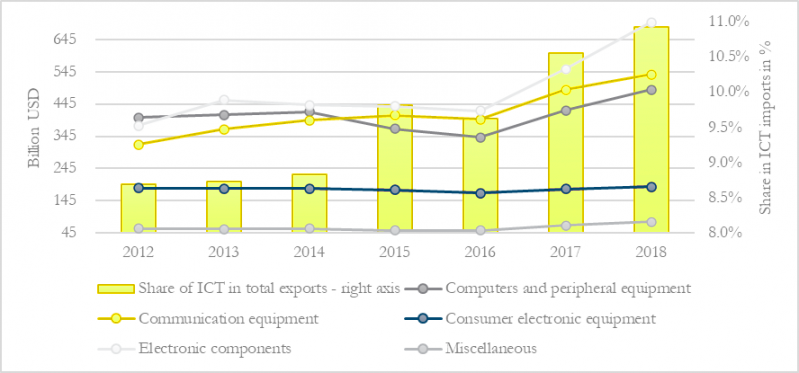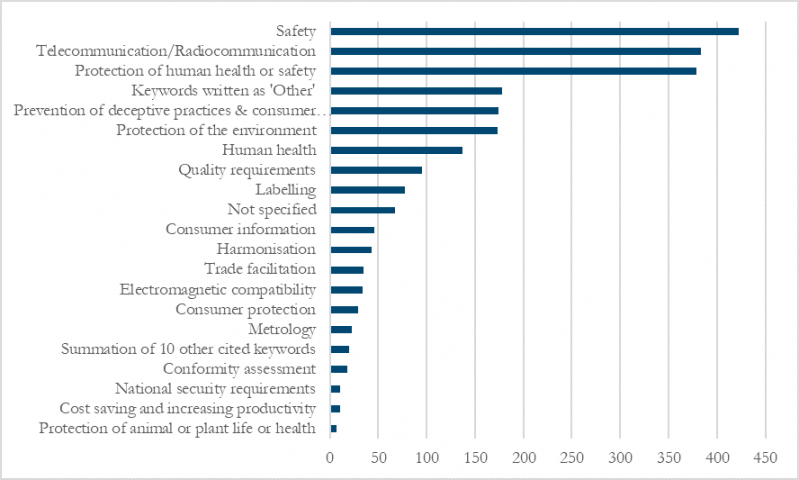_ Dr. Mahdi Ghodsi, economist, Vienna Institute for International Economic Studies (wiiw). 27 October 2021.*
Tariffs imposed on trade of goods in the information and communications technology (ICT) sector have been substantially reduced or eliminated since the conclusion of the Information Technology Agreement by the World Trade Organisation (WTO) in December 1996. However, use of regulatory non-tariff measures in the form of technical barriers to trade has been on the rise. In this short piece, we discuss how these important trade policy measures affect trade of ICT goods over the period 1996-2018.
Introduction
Digitalisation and globalisation are the two most important intertwined phenomena in the modern world. The information and communications technology (ICT) sector – also known as the ‘digital’ sector – has been the engine of growth since the transition into Industry 4.0 from the Third Industrial Revolution towards the close of the second millennium. On the one hand, the emerging technologies and increasingly advanced products in the digital sector have been reducing transactional and trade costs, stimulating trade significantly in recent decades, as the World Trade Organisation (WTO) reported in 2018. On the other hand, the globalisation process and the conclusion of plurilateral agreements have also stimulated trade of goods in the ICT sector.
Figure 1. Development of trade, tariffs and TBTs on ICT goods for WTO members – 1996-2018

Source: Ghodsi (2021).
In particular, the Information Technology Agreement that was concluded by the members of the WTO in December 1996 has reduced or eliminated tariffs levied by many countries on the imports of many goods in the ICT sector (see Figure 1). However, the use of other trade policy measures such as regulatory non-tariff measures (NTMs) in the form of technical barriers to trade (TBTs) has been on the rise. It is therefore important to understand how these most frequently used trade policy measures affect the trade of goods in the digital sector.
A recent wiiw working paper by Ghodsi (2021) that is part of a project on ‘The production side of digitalisation and its impacts’, financed by the Austrian National Bank (Oesterreichische Nationalbank), undertakes econometric analysis of how different types of TBTs pursuing various objectives affect the imports of ICT goods during the period 1996-2018. In this short piece, the main results of this study are presented.
Major categories of goods traded in ICT
The United Nations Conference on Trade and Development (UNCTAD) identifies ICT goods in five broad categories.2 Each of these goods may have a different functionality and use that can be clearly distinguished from other goods. Global import values of these categories are presented in Figure 2, with the share of ICT imports in total imports also shown. The most important category traded in 2018 was ‘electronic components’, which includes technologically advanced goods such as semiconductors that are produced in only a few countries but are widely used as intermediate inputs in the production of not only other ICT goods, but also in other sectors of the global economy such as automotive and machinery manufacture. During the COVID-19 pandemic, border closures have caused shortages in the supply of semiconductors, posing serious production challenges in many sectors.
Figure 2. Worldwide exports of ICT goods, billion USD by product category; share in total exports, 2012–2018

Sources: WITS; COMTRADE; UNCTAD; author’s elaboration; data collected in HS revision 2012.
The second major category in ICT exports is ‘communication equipment’, which covered around 27% of ICT exports in 2018. Sensitive political issues relating to the production of such equipment, and the maintenance of privacy and security despite surveillance of these products by giant Chinese tech firms such as Huawei and ZTE, and US tech producers such as Apple or Google, have become a challenging obstacle on the path of China-US diplomacy (Segal, 2018).
Objectives of TBTs targeting the imports of ICT goods
TBTs are regulatory trade policy measures that are imposed to regulate the importing markets, which are allowed by WTO agreements such as the TBT agreement. During 1996-2018 a total of 1,351 TBTs imposed on imports of ICT goods were notified to the WTO by member states. Depending on the coverage of products targeted by the TBTs, the number of bilateral tariff lines affected by these NTMs may be considerably larger than the number of notifications. TBTs pursue various objectives. TBT notifications usually contain extensive description of the regulatory measures and also some keywords, which usually relate to their purpose or objectives.
Figure 3 illustrates the number of TBT notifications citing various keywords. As can be seen, 422 TBTs imposed on ICT goods relate to consumer ‘safety’, the most frequently cited keyword. The second most frequently cited, ‘telecommunication/radiocommunication’, may define a set of standards for the specifications of ICT goods. There are also some TBTs that are aimed at regulating cross border trade flows. For instance, ‘harmonisation’, ‘trade facilitation’, or ‘conformity assessment’ are the regulations that may ensure smoother trade flows. However, TBTs citing such keywords are fewer in number than those protecting safety, human health or environmental qualities.
Figure 3. TBT notifications (based on keywords) in force in 2018 on ICT goods

Sources: WITS; COMTRADE; UNCTAD; WTO I-TIP; author’s elaboration.
How do TBTs affect trade in ICT goods?
Using their cited keywords, Ghodsi (2021) estimates the impact of various types of TBTs on imports of ICT goods. The results are robust against the endogeneity issues that usually cause bias, stemming from the reverse causality of trade policy measures and imports (among other biases). Such a reverse causality is triggered because a surge in imports may lead to the imposition of more trade policy measures by the importing government in order to regulate the importing market.
Nevertheless, the unbiased econometric results indicate that TBTs stimulate import values of ICT goods in a statistically significant manner. In fact, an additional TBT imposed on imports of ICT goods typically increases the import value in US dollars by about 2.2 percent. However, tariffs have no statistically significant impact on imports of ICT goods, which is not surprising as tariffs were reduced at the beginning of the period of analysis, after the conclusion of the Information Technology Agreement in 1996.
Distinguishing the impact of TBTs on imports by five categories of ICT goods, the marginal effect is statistically significant for only ‘communication equipment’. In other words, a 1 percent increase in the number of TBTs imposed on the imports of ICT goods stimulate import values in ‘communication equipment’ by 0.3 percent.
Which objectives of TBTs affect imports of ICT goods?
The econometric analysis using the keywords cited in the TBT notifications shows that only a few objectives that are the focus of TBTs have stimulated import values of all ICT goods in a statistically significant manner. These objectives are ‘conformity assessment’, ‘crime protection’, ‘electromagnetic compatibility’, ‘harmonisation’, ‘national security requirements’, ‘other’, ‘pesticides’, ‘plant health’, and ‘protection of animal or plant life or health’. However, as some of these objectives did not stimulate import volumes, one can argue that some of them have been increasing the price of imports, rather than stimulating trade. Moreover, two objectives – ‘food standards’ and ‘nutrition information’ have reduced import values of ICT goods in a statistically significant manner.
Conclusions and policy implications
As the digital sector is the beating heart of the modern factory of the world, trade in ICT goods could be considered its artery. As a result of the COVID-19 pandemic, the shortage of semiconductors – a complex and technologically advanced ICT good that is produced by only a few countries but used as an intermediate input in many manufacturing industries worldwide – illustrates the significance of trade in ICT goods.
WTO members first showed their commitment to facilitating trade in ICT goods by concluding the Information Technology Agreement in December 1996 to reduce or eliminate tariffs levied on trade of these goods. In December 2015 they agreed to extend this agreement to 200 more goods. As tariffs are at their lowest levels, they no longer have an impact on trade in ICT goods.
However, numerous regulatory NTMs in the form of TBTs with various objectives are currently imposed on imports of ICT goods. The empirical results presented here indicate that TBTs generally have a stimulative impact on trade of these goods. However, not every objective defined within a TBT serves to promote trade. Therefore, rather than a proliferation of TBTs that restrict trade, which are usually followed by retaliatory measures by trading partners, policy makers should aim to design frameworks to reduce unnecessary obstacles to trade and improve the mechanisms through which harmonisation of standards and regulatory NTMs could facilitate the use of ICT goods produced by any country.
Such mechanisms could be best designed in multilateral agreements by the WTO or bilateral agreements between advanced economies that could also improve minimum standards and regulatory frameworks in non-advanced economies. A harmonised set of standards and regulatory framework on the production side of ICT goods may eliminate mismatches in product specifications and will lead to diffusion of positive externalities not only in the ICT sector but also in many other sectors in the global economy. This will have a substantial impact on fostering export-oriented growth.
References
- Ghodsi, M. (2021), ‘Impact of Technical Barriers to Trade on the Trade in Goods in the Information and Communications Technology Sector: Differentiating by Aim of the Regulatory Measure’, wiiw Working Paper No. 208, The Vienna Institute for International Economic Studies (wiiw), Vienna, September.
- Segal, A. (2018), ‘When China Rules the Web: Technology in service of the state’, Foreign Affairs, Vol. 97(5), pp. 10-18.
- WTO (2018), ‘World Trade Report 2018. The future of world trade: How digital technologies are transforming global commerce’, Geneva.
*Republished with kind permission from the original: SUERF Policy Briefs (SPBs).
SUERF Policy Briefs (SPBs) serve to promote SUERF Members’ economic views and research findings as well as economic policy-oriented analyses. They address topical issues and propose solutions to current economic and financial challenges. SPBs serve to increase the international visibility of SUERF Members’ analyses and research. The views expressed are those of the author(s) and not necessarily those of the institution(s) with which the author(s) is/are affiliated.
